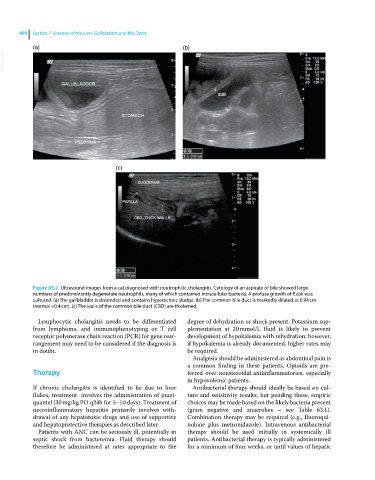Page 722 - Clinical Small Animal Internal Medicine
P. 722
690 Section 7 Diseases of the Liver, Gallbladder, and Bile Ducts
(a) (b)
VetBooks.ir
(c)
Figure 63.2 Ultrasound images from a cat diagnosed with neutrophilic cholangitis. Cytology of an aspirate of bile showed large
numbers of predominantly degenerate neutrophils, many of which contained intracellular bacteria. A profuse growth of E.coli was
cultured. (a) The gallbladder is distended and contains hyperechoic sludge. (b) The common bile duct is markedly dilated at 0.94 cm
(normal <0.4 cm). (c) The walls of the common bile duct (CBD) are thickened.
Lymphocytic cholangitis needs to be differentiated degree of dehydration or shock present. Potassium sup-
from lymphoma, and immunophenotyping or T cell plementation at 20 mmol/L fluid is likely to prevent
receptor polymerase chain reaction (PCR) for gene rear- development of hypokalemia with rehydration; however,
rangement may need to be considered if the diagnosis is if hypokalemia is already documented, higher rates may
in doubt. be required.
Analgesia should be administered as abdominal pain is
a common finding in these patients. Opioids are pre-
Therapy ferred over nonsteroidal antiinflammatories, especially
in hypovolemic patients.
If chronic cholangitis is identified to be due to liver Antibacterial therapy should ideally be based on cul-
flukes, treatment involves the administration of prazi- ture and sensitivity results, but pending these, empiric
quantel (30 mg/kg PO q24h for 5–10 days). Treatment of choices may be made based on the likely bacteria present
necroinflammatory hepatitis primarily involves with- (gram negative and anaerobes – see Table 63.1).
drawal of any hepatotoxic drugs and use of supportive Combination therapy may be required (e.g., fluoroqui-
and hepatoprotective therapies as described later. nolone plus metronidazole). Intravenous antibacterial
Patients with ANC can be seriously ill, potentially in therapy should be used initially in systemically ill
septic shock from bacteremia. Fluid therapy should patients. Antibacterial therapy is typically administered
therefore be administered at rates appropriate to the for a minimum of four weeks, or until values of hepatic

